Italy’s best region for white wines is the small but superb Collio district of Friuli. I have no doubt that others will dispute this proposition, but I’m very well prepared for the dispute, based on two relatively recent trips through the region and tastings of hundreds of wines from dozens of 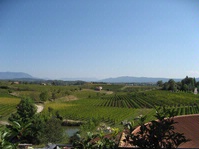 producers. Yes, Campania makes outstanding whites, as does Alto Adige and the area around Mount Etna in Sicily. However, Collio comes out on top when one carefully considers that its white wines show extremely high quality and strong consistency across a very broad set of grape varieties. Although Collio’s producers work with a wide array of grapes, the resulting wines show a strong commonality that can only be attributed to a great terroir. They combine generous richness with energetic acidity and prominent minerality, and they are remarkably age-worthy.
producers. Yes, Campania makes outstanding whites, as does Alto Adige and the area around Mount Etna in Sicily. However, Collio comes out on top when one carefully considers that its white wines show extremely high quality and strong consistency across a very broad set of grape varieties. Although Collio’s producers work with a wide array of grapes, the resulting wines show a strong commonality that can only be attributed to a great terroir. They combine generous richness with energetic acidity and prominent minerality, and they are remarkably age-worthy.
Collio isn’t famous yet, but its wines are utterly convincing, so we should start with a question: If these wines are so good, why aren’t they more widely known? For starters, the region is relatively compact, and its boundaries are much more narrowly drawn than, say, Alto Adige. Moreover, the overwhelming majority of producers are small, family-owned enterprises, and there is no truly big producer with the funds and inventory to disseminate the Collio “brand” world-wide (as Ste. Michelle has done for Washington). A related factor is that small producers don’t enjoy the economies of scale that make inexpensive wines possible, so Collio releases very few wines at truly low prices that can entice first-time buyers. Additionally, a few of the most famous producers don’t use the Collio DOCG appellation for all of their wines, as in the important case of Jermann’s Pinot Grigio.
A final factor of enduring importance is fully a century old. During World War I, fighting between the Italians and the Austro-Hungarian empire stalled along a line running right through Collio’s prime growing region. Over the course of about 19 months, nearly 60,000 died along this stationary front, and virtually every vine and tree was literally shredded by a constant exchange of fire. Viticulture didn’t resume 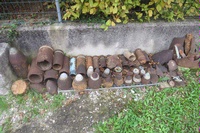 appreciably until a full decade after the war, and has only risen slowly to levels approaching the extent of pre-war plantings. Artillery shells continue to be found in the vineyards to this day. When Italy finally recovered economically from World War II sufficiently to resume its appreciation for fine wine and dining, it was almost all about red wine until sometime in the 1980s. Today, fine Italian whites and sparkling wines such as Franciacorta have become highly respected, but their stature within Italy and beyond it remain far below the level they merit in comparison to their worldwide counterparts.
appreciably until a full decade after the war, and has only risen slowly to levels approaching the extent of pre-war plantings. Artillery shells continue to be found in the vineyards to this day. When Italy finally recovered economically from World War II sufficiently to resume its appreciation for fine wine and dining, it was almost all about red wine until sometime in the 1980s. Today, fine Italian whites and sparkling wines such as Franciacorta have become highly respected, but their stature within Italy and beyond it remain far below the level they merit in comparison to their worldwide counterparts.
Be that as it may, the quality of Collio’s whites is so consistently high that fame is only a matter of time. This will eventuate first for the whites, which comprise about 85% of production in the region. Reds are likely to become somewhat more prominent as the climate warms gradually, but for now, the region is really most likely to be known–like Alsace–almost entirely as a prime source for whites. Also like Alsace, most producers work with a fairly wide array of grape varieties. But unlike Alsace, where Riesling seems to be getting increasingly sweet and Pinot Gris is on the verge of becoming uselessly blowzy, almost all of Collio’s whites are finished dry.
But here’s what’s most impressive about Collio’s whites: On one hand, they show very sharply delineated varietal character, and even a novice taster could quickly identify whether he or she is tasting Pinot Grigio, Friulano, Malvasia, Sauvignon, Ribolla Gialla, Chardonnay or Pinot Bianco. But on the other hand, all the wines show a strong family resemblance to one another, a deeply etched terroir signature marking a Collio white as expressively aromatic, generously rich, crisply structured, and assertively mineral — even to the point of seeming spicy.
These descriptors appear again and again in the tasting notes from my two trips, but they only convey half of what is most exciting about these whites. Beyond their static elements is the dynamic interplay between ripe, broadly textured fruit and zesty, driving acidity.
This is not hyperbole. The whites are almost invariably refreshing, with lots of linear energy, and yet they routinely show so much breadth and richness that I often caught myself checking labels to read alcohol levels. These were often pretty high, and yet very few of the wines showed any overt alcoholic heat in their aromas or finish. The ripeness of the wines was evident, but so too was a mineral undertone and an acidic balance that rendered it un-problematic.
Another way to convey the distinctive style of Collio whites is to note this: They show an uncanny combination of warm climate ripeness with cold climate structure, and they show this combination across vintages, grape varieties, sub-districts, and producers. It is a very engaging profile, and it makes for wines that work very well at the table while also proving very enjoyable as sippers.
Clearly this profile is strongly influenced by the local climate, which in turn is influenced by regional geography. The tendency toward ripeness in the wines can be traced to warm currents from the nearby Adriatic sea as well as hillside exposures to the sun. By contrast, the crisp, structured 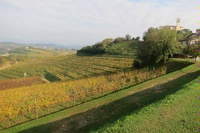 aspect of the wines can be traced to the region’s exposure to cool winds from central Europe and Russia. These winds are moderated by the proximity of the Alps, which is very fortunate since there’s a fine line between harmful cold and helpful cool. Most of Collio’s vineyards are situated equidistant between the mountains, resulting in very consistent temperature swings between days and nights during the growing season.
aspect of the wines can be traced to the region’s exposure to cool winds from central Europe and Russia. These winds are moderated by the proximity of the Alps, which is very fortunate since there’s a fine line between harmful cold and helpful cool. Most of Collio’s vineyards are situated equidistant between the mountains, resulting in very consistent temperature swings between days and nights during the growing season.
In terms of location for making white wine, Collio sits in a spot that lies very close to perfection. You might think that I’m being overly enthusiastic when writing this, but if so, ask yourself: If Collio’s growing conditions weren’t very close to optimal, would it be possible to produce wines at the very highest global level of quality from at least seven distinct grape varieties?
Here’s another important indicator of excellence: Collio’s white wines are phenomenally age-worthy. By this I mean not only that they can hang on over time, but also that they improve with time, achieving greater 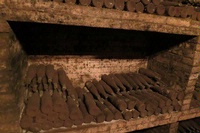 aromatic complexity as well as integration of flavor and structural components–and doing all of this without losing freshness and acidic "cut." This is true across the entire range of grapes, including even varieties that are routinely regarded as suitable only for immediate consumption–such as Pinot Grigio or Sauvignon Blanc. I review dozens of top wines below, and you should keep an eye on the vintage dates. And if you encounter a Collio white that is a few years old on a restaurant list or in a retail shop, you should jump on the opportunity to taste it.
aromatic complexity as well as integration of flavor and structural components–and doing all of this without losing freshness and acidic "cut." This is true across the entire range of grapes, including even varieties that are routinely regarded as suitable only for immediate consumption–such as Pinot Grigio or Sauvignon Blanc. I review dozens of top wines below, and you should keep an eye on the vintage dates. And if you encounter a Collio white that is a few years old on a restaurant list or in a retail shop, you should jump on the opportunity to taste it.
Since Collio’s climate can ripen a range of white grapes to near perfection, you might well be wondering about reds in the region, and here the good news continues. Although whites remain predominant in the area, the reds are (not just “can be”) very good. Made mostly from Refosco, Cabernet Franc and Merlot, along with a little Pinot Nero and Cabernet Sauvignon and a few other bit players, they are balanced, restrained and mineral.
Whenever I use a descriptor such as “restrained” for red wines, I worry that this might look like “damning with faint praise” to those who love whopping Zinfandel and Shiraz wines. And, actually, that’s probably the correct reading for those with this sort of palate preference. However, those who love medium-weight red wines from places like Burgundy or the northern Rhône or Piedmont will likely love what they find from Collio, where reds are full of flavor without any extraneous weight or jammy ripeness.
It is important to emphasize that Collio’s reds are consistently ripe and convincing, unlike reds from other places that specialize in whites but also make reds. To be specific, red varieties are manifestly more at home in Collio than in Alsace or the Loire or Switzerland or Germany. All of those places make good red wines. Plus lots of thin, weedy ones–except in unusually warm years. All four of these places have climates that are generally quite marginal for red wine production, though a warming climate is gradually changing that.
The situation is subtly — but importantly — different in Collio. Its climate is also marginal for reds, but “marginal” means something different there, namely, highly suitable for certain varieties like Merlot and Cab Franc, though not for Grenache or Mourvedre. By contrast, almost all red varieties routinely struggle to achieve ripeness in Alsace, the Loire, Switzerland and Germany.
Aside from red wines and single-variety whites, Collio produces several other notable wine types. Sparkling wines are made almost exclusively from Ribolla Gialla (which is suitable on account of its unusually high 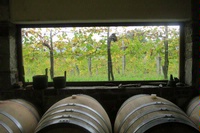 acidity), and they can be quite good. Naturally, since Chardonnay and Pinot Nero are also grown in the area, other producers are tempted to base sparklers on these, as in Champagne. Sweet wines are also produced fairly widely, and for these it is the Picolit grape that is most often utilized. Results can be very, very good — if not quite at the world’s highest level for dessert wines.
acidity), and they can be quite good. Naturally, since Chardonnay and Pinot Nero are also grown in the area, other producers are tempted to base sparklers on these, as in Champagne. Sweet wines are also produced fairly widely, and for these it is the Picolit grape that is most often utilized. Results can be very, very good — if not quite at the world’s highest level for dessert wines.
Two remaining wine types that remain rather obscure in world markets are nevertheless potentially extraordinary, and truly merit the attention of connoisseurs in all quarters.
The more mainstream of these is Collio Bianco DOC, which is a highly variegated category of blended white wines. Although many producers base their Collio Bianco on local varieties, namely, Ribolla Gialla, Friulano and Malvasia, the DOC regulations permit French varieties as well, so it is never obvious what’s in a bottle bearing this designation. Nor is it apparent how the wine was made, as some producers vinify in neutral stainless steel, whereas others utilize new or new-ish barriques and still others use less assertive oak (meaning older barriques, 500 liter casks, or big ovals).
The thread of continuity running through the various renderings of Collio Bianco is that producers seem to regard their particular renditions as personal statements, with the consequence that they vector much of their attention and a lot of their best fruit toward these wines. I walked out of more than one cellar believing that the best of all the wines was the producers’ Collio Bianco, and you would be well advised to try these whenever you encounter them.
A remarkable last category for consideration is the so-called “Orange Wines” made from Ribolla Gialla in and around the commune of Oslavia. Although local producers aspire to a DOCG classification for Ribolla di Oslavia, there’s not yet any official designation for these outlandish wines, which are currently labeled Collio DOC with the variety identified or, in some cases, Venezia Giulia IGT. Ribolla Gialla is the grape behind the entire category, and the fruit is typically left on the vine for as long as possible and then macerated for a very long time as if it were red wine that was being made.
Macerations may continue for one to nearly four months (!), with some producers then pressing the grapes and returning them to big old casks for years before they are readied for sale. Striking in appearance, they range from golden to copper to amber to screaming orange, which seems an impossible outcome for a white grape, though producers attribute this to the effects of extreme hang time on vines as well as extended skin contact. Big and assertive but not sweet, they can display explosive aromatics and amazing tannic grip, but in the best renditions this muscularity coincides with surprising intricacy and freshness, with remarkable notes of apricots, mandarin oranges, and preserved lemons.
Summing up, Collio is not only an outstanding wine region, but also a terrific travel destination. Situated relatively near to Venice, the area holds huge potential for wine tourism growth, and many of the producers  I visited have recently built inviting guest rooms. Although the wines are definitely an attraction in themselves, there are many other alluring options nearby: Quick side trips into the lovely city of Trieste, or up into the Alps, or into Slovenia, or down the nearby (and famously beautiful) coast of Croatia. Every wine lover headed to Venice should consider including Collio in his or her trip itinerary.
I visited have recently built inviting guest rooms. Although the wines are definitely an attraction in themselves, there are many other alluring options nearby: Quick side trips into the lovely city of Trieste, or up into the Alps, or into Slovenia, or down the nearby (and famously beautiful) coast of Croatia. Every wine lover headed to Venice should consider including Collio in his or her trip itinerary.
I hope that you’ll enjoy a chance to travel to Collio yourself someday, but for now, you’d do well to whet your appetite by tasting some of the wines. The list of reviews below is extremely long, so I am going to omit tasting notes for sparkling wines (which are rarely exported) as well as “Orange Wines” (which are likewise rare and also quite expensive).
All wines appearing below are listed within categories by type or grape variety, with top-scoring wines appearing first in order. Wines with identical scores are ordered alphabetically. Few of the wines have national importers, as production quantities tend to be small, making it logistically preferable for most Collio producers to work with regional importers and distributors in the USA. Prices can vary widely, so I’ve elected not to indicate these for fear of doing more harm than good. If you wish to track down a particular wine, your best bet is to check availability and pricing via a Web search. The day will come when Collio’s whites are famous and readily available, but when that day comes, they will also be very expensive. So, don’t resent the effort required to find the wines described below, as you’ll be getting something terrific for a price that will soon look very attractive in retrospect:
COLLIO BIANCO:
Gradis’ciutta "Bratinis" 2011: For many producers, Collio Bianco is the house’s flagship wine, but it can’t quite be the region’s flagship wine due to the fact that the varieties in the blend differ among producers. Gradis’Ciutta (an exemplary producer) always uses Ribolla Gialla, Chardonnay and Sauvignon Blanc, and always draws the fruit from the same vineyard sites. There is some vintage variation, however, due to differences in the warmth and yield levels of different growing seasons. I haven’t tasted enough different renditions to know how the 2011 stacks up against other vintages, but I tasted this particular wine on three separate occasions…and adored it all three times. Not only is it still alive at this stage, but actually quite vibrant and highly complex, with multiple layers of generous flavors and a very long, symmetrical finish. It is so complex that it seems impossible that no wood was involved, but that’s indeed the case. It starts with a super complex bouquet, followed by flavors that are very generous and almost succulent and tropical. These are mid-palate sensations; as the wine finishes, acidity gracefully supersedes the juiciness and provides remarkable refreshment value for a wine from a warm growing season. Starting lavish but then turning energetic, this provides a surprising and downright exciting tasting experience. 94
Borgo del Tiglio “Studio di Bianco” 2011: Really ripe and generous in character, this is a wine with a lot of ripeness and weight on the palate but no lack of focus or freshness. The generous fruit notes recall tangerine and mango, but just when this seems that it might be a bit too juicy, the late-arriving acidity energizes the finish. Wines from the 2011 vintage in Collio often show this unusual sensory characteristic of late-arriving acidity, and this is a fine case in point. Broadening out beyond the year, this also offers an object lesson in the unusually rich-but-sharply-defined template of Collio whites. 93
Carlo di Pradis 2005 ($28): If you need proof that the top wines of Collio are amazingly age-worthy, this is the bottle that will prove the point. This has not only held on for a decade, but developed and improved in multiple aspects. The color shows the effects of time in bottle, but the oxidative notes shown in the wine’s aromas and flavors are all positive, lending complexities akin to those found in perfectly aged Champagnes. The bouquet is especially marked by tertiary characteristics, but primary fruit is still showing from start to finish in the sensory sequence offered by this wine. Its layered profile is also underpinned by remarkably prominent minerality that cannot only be tasted but actually almost felt on the palate as the wine’s flavors tail off in an impressively persistent finish. 93
Pascolo “Agnul” 2006: This superb wine is usually blended from 50% Friulano (that is barrel aged) along with 40% Pinot Bianco and 10% Sauvignon, though in this vintage a small amount of Malvasia was 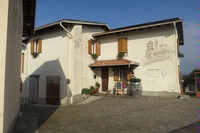 included. “Agnul” is Friulian word for Angel, after Angelo, the current proprietor’s grandfather. Pale gold in color after 9 years since vinification, it shows some oxidative development, but all of this is positive in sensory terms, and the wine is far from over-the-hill despite being fully mature. The aromas recall honey and toasted nuts, and the fruit component is reminiscent of poached pears. The wine is now thoroughly integrated, with the oak virtually undetectable as an overt element, and it shows a wonderful layer of subtle minerality in its very long finish. I also tasted this wine from 2009 and 2010, but this was clearly the pick of the litter. 93
included. “Agnul” is Friulian word for Angel, after Angelo, the current proprietor’s grandfather. Pale gold in color after 9 years since vinification, it shows some oxidative development, but all of this is positive in sensory terms, and the wine is far from over-the-hill despite being fully mature. The aromas recall honey and toasted nuts, and the fruit component is reminiscent of poached pears. The wine is now thoroughly integrated, with the oak virtually undetectable as an overt element, and it shows a wonderful layer of subtle minerality in its very long finish. I also tasted this wine from 2009 and 2010, but this was clearly the pick of the litter. 93
Ronco Blanchis “Blanc di Blancis” 2013: Blended from Friulano, Chardonnay, Sauvignon Blanc and Malvasia, this medium-bodied wine starts with subtle but intricate aromas, followed by fleshy texture and open flavors that are focused by fresh acidity. Quite detailed and layered in profile, with exceptional quality in its aromatics, flavors and texture. 93
Ca’Ronesca “Marnà” 2010: This is a wonderfully complex and expressive wine. The aromas are quite alluring, but the real fireworks start once the flavors kick in, starting with opulent tropical fruit and mandarin orange notes. A subtle undertone of stony minerality rises to the fore in the finish as the fruit flavors tail off, and the string of sensations is energized throughout by a strong streak of citrus acidity. If my score is off, it is off on the low side, and this impressive wine offers yet another object lesson in the capacity of Collio whites to improve with extended ageing. 92
Livon “Solarco” 2013: Made from Friulano and Ribolla Gialla, this terrific wine shows an exciting synergy of two local varieties. The bouquet offers subtle herbal scents as well as open notes of peach and mango, with flavors that follow suit but are supercharged by driving acidity that is presumably derived from the Ribolla component. Rich yet sharply focused, this combines characteristics that are very desirable but rarely combined…except in Collio. 91
Terčič “Planta” 2011: An outstanding wine from a difficult vintage, this shows an uncanny combination of creaminess and cut, with rich fruit recalling lemon curd that actually sharpens rather than dulls as the flavors tail off in the finish. Complex in structure as well as flavor, this is a wine that would prove enduringly interesting to drink. 91
FRIULANO:
Toros 2013 ($22): Among the handful of best Friulano wines that I’ve ever tasted, this is exceedingly complex and expressive, with all of its aromas and flavors apparently derived from fruit rather than wood or cellar tricks. The floral, fruity and mineral notes are all quite distinct and yet all exceptionally harmonious. When a wine performs at this high a level, the only possible explanation is that the fruit drawn from the vineyard was, well, perfect. 94
Muzic 2013: This is an outstanding rendition of one of Collio’s signature grape varieties. Substantial and generous on one hand, but fresh and energetic on the other, it is exceptionally well balanced, with fruit and acidity working in tandem to create a very interesting tasting experience. Along with light floral aromas and flavors marked by stone fruit and mandarin orange notes, there’s also a striking suggestion of celery that makes this especially distinctive. 93
Picéch, Collio 2013: This is probably my favorite wine from the Picéch family, which operates a lovely accommodation amidst a beautiful stretch of Collio’s vineyards and also operates a top-notch winery. A totally 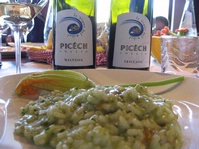 convincing and charming rendition of Friulano, this wine offers lots of lifted flora aromas and then backs them up with real depth of fruit based on tropical and mandarin notes. Despite the wine’s juiciness on the palate, it never seems obvious or sweet, and indeed the finish is marked by an interesting mineral tone rather than sweetness. Tasted on three separate occasions, this wine was a star at each showing. 93
convincing and charming rendition of Friulano, this wine offers lots of lifted flora aromas and then backs them up with real depth of fruit based on tropical and mandarin notes. Despite the wine’s juiciness on the palate, it never seems obvious or sweet, and indeed the finish is marked by an interesting mineral tone rather than sweetness. Tasted on three separate occasions, this wine was a star at each showing. 93
Sturm 2013: This is a surpassingly complete and complex Friulano, with terrific fruit at its core surrounded by floral and mineral accents that are extremely appealing. In structural terms, it shows excellent definition and acidic cut, yet still seems quite generous and almost rich despite its lovely freshness. Outstanding. 93
Borgo del Tiglio 2011: A wonderfully interesting wine, this has aged beautifully, and is now showing very expressive minerality as the floral aromatics and primary fruit have settled down over time. Although it doesn’t have the palpable acidic cut of a new release, it remains very fresh in overall impression, and everything that has been deducted during its maturation has been repaid — with interest — by other elements indicating positive development. 92
Branko, Collio 2013: This rather unusual rendering of Friulano from Branko shows the variety’s prominently “feminine” aspect in its graceful, lifted, fresh finish. And yet, the wine is also admirably concentrated and deeply flavored, with weight that makes it seem surprisingly “masculine” as well. Superb purity of fruit serves to unify these rather divergent sensory impressions, providing the wine with an overall harmony despite its interestingly layered character. 92
Carlo di Pradis 2013: An excellent example of Friulano, this is relatively reserved in aromatic terms, but shows excellent concentration and lots of acidity and minerality that sharply define the flavors while lending interest and persistence to the finish. 92
Livon “Manditocai” 2013: This seems to show wood influence on both the nose and palate, and yet the overall profile of the wine is very fresh and even energetic, with excellent acidic cut that never seems to outrun oak so effectively. Very faint floral aromas work beautifully with fruit and spice notes that mark the flavors and finish. The only wine this resembles would be a superb barrel fermented Albariño, but that’s not all that helpful on account of the fact that this is a better wine than any barrel fermented Albariño I’ve ever tasted. 92
Primosic "Belvedere" 2013: Sourced from a single site, this is a remarkably complex, layered, elegant Friulano. It shows an uncanny 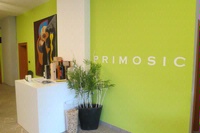 combination of creaminess on the palate but edginess in the finish that really marks it as a wine from Collio… so much so that it would seem impossible any place else. The lovely flavors recall mandarin oranges and stone fruit, and though these are quite generous, there’s still an overall sense of subtlety to the wine.
92
combination of creaminess on the palate but edginess in the finish that really marks it as a wine from Collio… so much so that it would seem impossible any place else. The lovely flavors recall mandarin oranges and stone fruit, and though these are quite generous, there’s still an overall sense of subtlety to the wine.
92
Renato Kerber 2012: Knowing that this wine was made from the 2012 harvest made me skeptical initially that it could succeed in remaining fresh, but that’s exactly what it did. Although the floral aromatic notes have receded somewhat and the wine shows rather gentle acidity at this point, it excels on the strength of very deep flavors and seamless integration. 91
Ronco Blancis 2013: A wonderfully fresh rendering of Friulano, this was apparently bottled early with refreshment value in mind, as a bit of unresolved carbon dioxide shows in the form of bubbles in the glass. This provides additional lift to a wine that is already quite energetic and crisp, which are highly desirable characteristics in a wine featuring floral and tropical aromas and flavors. Immediately endearing, but also enduringly so. 91
Venica “Ronco delle Cime” 2013: Friulano from Collio can be a quite dramatic wine, with big floral aromas that can sometimes seem a bit overblown. However, this is an especially stylish take on the variety from Venica, showing subtle aromas, broad flavors, and zesty finishing acidity. Delicate and drinkable rather than overly demonstrative, this is a very convincing rendition of one of Collio’s signature varieties. 91
MALVASIA:
Gradis’ciutta 2013: A terrific take on Malvasia, this wine shows very deft winemaking, and there’s no doubt that the work in the vineyard must also have been excellent. The evidence for this comes in the form of very expressive aromas and flavors–as one might expect from this variety–but with terrific length and structure for a wine made from an floral grape. The balance is so fine that the wine manages to seem opulent and restrained at once, which is an uncanny combination. 92
Livon "Soluna" 2013: There isn’t a lot of varietal Malvasia made in Collio, but the best examples are so good that one wonders why there aren’t more of them in commercial circulation. The superb rendition shows heady floral aromatics and a wonderfully opulent mandarin orange mid-palate, yet it also achieves excellent balance thanks to fresh acidity and a streak of citrus pith bitterness that adds definition to the finish. 92
Venica “Pètris” 2013: Venica makes terrific Malvasia almost every year from a strain of the variety that they believe is distinct from most others. Be that as it may, the 2013 shows lovely floral aromatics followed buy juicy, generous flavors that show multiple dimensions but recall mandarin oranges above all. A wonderful foil for antipasti, especially salty charcuterie. 92
PINOT BIANCO:
Russiz Superiore Pinot Bianco Riserva 2007: That’s right–Pinot Bianco from 2007–and the wine is still singing. This has not only proved durable over the years, but actually improved even with extended ageing. With medium-plus body and a rich mouthfeel, it is a quite generous wine, yet also subtle and elegant, as is fitting for Pinot Blanc / Bianco. It is starting to show the slightest whiff of alcoholic heat in the finish, so the time has come to uncork this, but the fact that the time to uncork it hasn’t already passed is pretty damned impressive. 91
Venica “Tàlis” 2013: Pinot Bianco is one of the world’s most delicious and versatile wines with food, and yet it is also among the most under-appreciated. Collio is a particularly good source for excellent examples, and this rendition from Venica (a.k.a. Venica & Venica) shows fine balance between the creamy and defined characteristics that the grape variety can show. It isn’t strikingly complex, but subtlety is the whole point of fine Pinot Bianco / Blanc, and this wine is subtle without seeming mute. Excellent, and likely to get even better over the next year. 90
PINOT GRIGIO:
Primosic “Murno” 2013: This standout rendition of Pinot Grigio was sourced from a single vineyard planted in the 1970s…long before Grigio became a consumer fad and was planted in all sorts of places that were best suited to cranking out large quantities of innocuous wines. Aromas of subtle smoke and musk get this off to a great start, and medium body provides satisfying substance on the palate. Layered in character thanks to tinges of minerality and a fruit note reminiscent of apricot skin that lingers through the finish, this is excellent now but also capable of holding or even improving for another couple of years. 92
Villa Russiz 2013: Villa Russiz is an historic and exemplary producer in 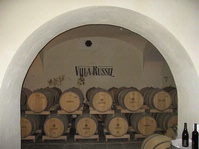 many different respects, one of which is that it makes one of the world’s most convincing renditions of Pinot Grigio. Whereas this is usually a non-descript wine category, the Villa Russiz 2013 (still going strong) is quite complex and uncanny in its combination of seamless integration along with interesting interplay between fruit and acidity. This vintage was described to me as a “perfect” harvest that was conducted over a long span of 25 days
many different respects, one of which is that it makes one of the world’s most convincing renditions of Pinot Grigio. Whereas this is usually a non-descript wine category, the Villa Russiz 2013 (still going strong) is quite complex and uncanny in its combination of seamless integration along with interesting interplay between fruit and acidity. This vintage was described to me as a “perfect” harvest that was conducted over a long span of 25 days
